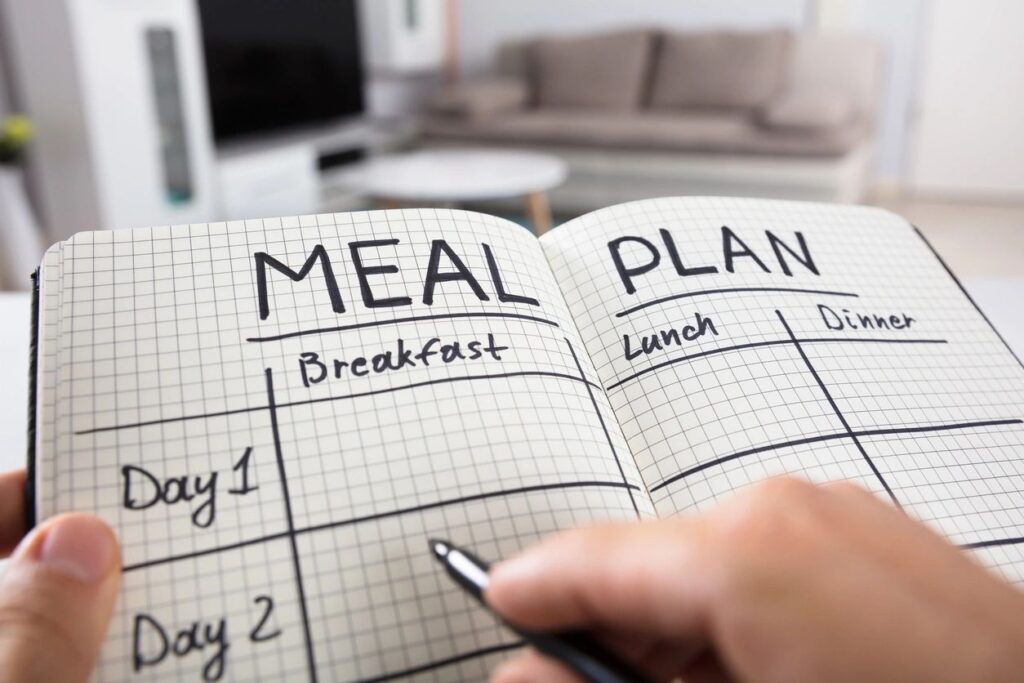
Lifestyle
Healthy habits are crucial for a long and healthy life. One study compared those with healthy habits with the rest of the population. On average, those with healthy habits lived more than a decade longer!
The decisions we make daily may seem unimportant. Yet they add up over the months and years.
Our lifestyle influences how we look and feel. It can help us rest well and even adds years to our lifespan.
If you’d like to improve your lifestyle, you may be wondering where to begin. In this section of our website, you’ll find information on four different topics: sleep habits, meal plan, takeout and grocery, and work life balance.
We recommend starting small. Instead of trying to change all your habits at once, choose just one area to improve. Doing so will prevent you from feeling overwhelmed and will be more sustainable in the long run.
We invite you to read the whole page for a well-rounded understanding of a healthy life! Or, if you prefer, you can jump to the section that corresponds with your lifestyle goals.
The Power of Sleep Habits: Rest Well for a Brighter Tomorrow
Sleep is like a magic elixir for our bodies and minds. It’s not just a time when we shut our eyes and dream. It’s a vital part of our well-being.
Good sleep habits can transform our lives by boosting our energy, mood, and overall health. Let’s delve into the importance of sleep habits. Then, we’ll discover some tips to enhance our nightly slumber.
Sleepy Science: Why Sleep Matters
During sleep, your body isn’t idle. Instead, it’s buzzing with essential tasks. It repairs tissues, builds muscles, and bolsters your immune system.
Just like your smartphone needs to recharge, your brain craves rest too. Sleep helps:
- Consolidate memories
- Sharpen focus
- Amp up creativity
A night of deep sleep is like a mood-boosting potion. Without it, crankiness and irritability often tag along. Moreover, sleep is a great mechanism against stress.
When you rest well, your stress hormones take a backseat. This allows you to wake up ready to conquer the day.
Sleep Habits: Keys to Better Rest

If your sleep quality isn’t the greatest, the culprit may be your habits. Habits can make or break your sleep quality. Let’s shed light on a few crucial ones.
Consistent Schedule
Your body loves routines. Going to bed and waking up at the same time, even on weekends, helps set your internal clock. Your body knows when it’s time to power down and when it’s time to wake up.
Dreamy Environment
Your sleep space should be cozy and inviting. A comfortable mattress, cool room temperature, and dim lighting can create a sleep haven. If noise is an issue, consider earplugs or soothing white noise.
Tech Timeout
Blue light from phones and screens can mess with your sleep hormone, melatonin. An hour before bed, say goodnight to your devices. Swap them for a book, gentle music, or meditation.
Belly-Friendly Dining
Eating a heavy meal before bed can cause discomfort and disrupt sleep. Opt for a light snack if your tummy grumbles. Avoid caffeine and nicotine too close to bedtime.
Exercise Wisdom
Regular physical activity can improve sleep, but timing matters. Exercising close to bedtime might leave you too pumped to snooze. Aim for a workout earlier in the day.
Snooze-Worthy Tips
We’ve talked about some practices that are detrimental to sleep. Enough with the theory! Let’s dive into practical tips for cultivating healthy sleep habits.
- Create a relaxing pre-bed routine: A warm bath, some calming herbal tea, or a few pages of a book can signal to your body that it’s time to unwind
- Mindfulness meditation: Spending a few minutes in mindfulness meditation can clear your mind and prepare it for rest
- Limit daytime naps: While a short nap can be refreshing, lengthy siestas longer than 30 minutes can prevent nighttime tiredness
- Limit liquid intake before bed: Sipping too much before bedtime might lead to midnight bathroom breaks
- Don’t toss and turn: If you can’t fall asleep, get up and do something relaxing until you’re drowsy
- Expose yourself to natural light: Sunlight helps regulate your internal clock, so aim for some outdoor time during the day
- Limit caffeine and alcohol: Avoid caffeine in the afternoon and limit alcohol consumption close to bedtime
- Stay active: Regular exercise can improve sleep, but avoid vigorous workouts too close to bedtime
- Journal your worries away: Jot down your worries or tasks for the next day to clear your mind and prevent bedtime anxiety
- Stay positive: If you’re struggling with sleep, stressing about it can make matters worse
Transform Your Sleep Habits
In a world bustling with activity, sleep often takes a backseat. But remember, sleep is your ally, your rejuvenator, and your ticket to better health and a brighter mind.
Embrace the power of sleep habits and watch your life transform as you rest well night after night. With a few simple changes, you can welcome more vibrant days, a sunnier mood, and a healthier body.
Mastering Meal Plans: Nourishing Your Body, One Bite at a Time

Imagine your body as a finely tuned machine, and food as the fuel that keeps it running smoothly. Meals are not just a list of what to eat, but a roadmap to a healthier you.
Let’s delve into the significance of meal plans. Then we’ll unlock the secrets to crafting a nourishing and balanced eating regimen.
Meal Plans: Why They Matter
Meal plans are more than just a trendy idea. They’re a fundamental tool for achieving optimal health.
Without a meal plan, your food choices could veer off track. Yet, the right meal plan is like a map to guide you to healthier nutrition. Here are some reasons why having a mean plan is crucial.
Nutritional Balance
A well-crafted meal plan ensures you get the right mix of nutrients. They help you balance:
- Proteins
- Carbohydrates
- Healthy fats
- Vitamins
- Minerals
This balance fuels your body’s functions, from energy production to immune support.
Portion Control
Portion sizes can be deceiving. When you’re dieting, overeating is a common pitfall. Meal plans help you gauge appropriate portion sizes, preventing excess calorie intake.
Weight Management
Whether you’re aiming to shed a few pounds or maintain a healthy weight, a meal plan provides structure.
A well-thought-out meal plan encourages mindful eating. If you know what you’ll be eating, you’re less likely to resort to quick, unhealthy options. As a result, it’s easier to manage your calorie intake.
Consistency and Routine
Meal plans establish a routine, making it easier to stay on track with your dietary goals. Regular eating times can help stabilize blood sugar levels. It also prevents unhealthy snacking.
Time and Stress Management
Planning meals in advance reduces last-minute food decisions. This saves time. It also lowers stress, especially during busy days.
Crafting Your Culinary Compass: Tips for a Healthy Meal Plan
We’ve highlighted the importance of meal plans. Now, let’s roll up our sleeves and create one that’s vibrant with a rainbow of fruits and veggies. Here’s a step-by-step guide to crafting a healthy meal plan.
Set Your Goals
Before you dive into meal planning, identify your goals. Do you want to lose weight, gain muscle, boost energy, or simply eat more nutritiously? Your goals will shape your plan.
Assess Your Caloric Needs
Calculate your daily caloric needs. Consider factors such as:
- Goals
- Age
- Gender
- Activity level
- Metabolism
This will guide you in determining portion sizes and overall meal composition.
Embrace Whole Foods
Base your meal plan on whole, unprocessed foods. These are nutrient powerhouses that fuel your body with vitamins, minerals, and fiber. Think colorful fruits, veggies, lean proteins, whole grains, and healthy fats.
Plan Your Plate
Visualize your plate as a canvas and fill half with vegetables and fruits. A quarter should have lean protein (like chicken, fish, or legumes). The remaining quarter should be whole grains (such as quinoa or brown rice).
Variety is Vital
Keep your taste buds intrigued by incorporating a variety of foods. Experiment with different types of cuisine, spices, and cooking methods. This will keep meals exciting.
Prep Ahead
Once you’ve planned your meals, prepare as much as you can in advance. Chop veggies, cook grains, and marinate proteins ahead of time. This will make meal assembly easier and improve your chances of sticking to your plan.
Mind the Portions
Portion control tools can help you gauge appropriate serving sizes. Measuring cups work best at first. Over time, you’ll become better at eyeballing portions.
Flexibility Matters
Life can be unpredictable, and your meal plan should accommodate that. Be flexible and open to adjustments. This will help you stay aligned with your nutritional goals instead of letting life get in the way.
Meal planning doesn’t have to be rigid or complicated. It’s a tool to empower you, providing a roadmap to a healthier and more balanced life. With each thoughtfully planned meal, you’re investing in a brighter, more energized, and happier you.
Navigating Groceries and Takeout

The aisles of grocery stores and takeout menus present a world of culinary possibilities. They hold the key to satisfying your hunger and nourishing your body. But in the pursuit of health, how do you make the wisest choices?
Let’s embark on a journey through groceries and takeout. Along the way, we’ll discover how to select nutritious food that harmonizes with your meal plan.
Groceries: Your Nutrient Treasure Trove
In the grocery store, there are many nutritional gems waiting for you to discover. Armed with your meal plan and a few savvy strategies, you can fill your cart with foods that align with your health goals.
Here are some tips to help.
Shop the Perimeter
In most grocery stores, the freshest and healthiest options are often found along the perimeter. Fresh produce, lean proteins, dairy, and whole grains tend to be here. Take a stroll and gather vibrant fruits, vegetables, and lean cuts of meat.
Read Labels with Care
As you venture into the central aisles, where packaged goods are, become a label detective. Scan for hidden sugars, excessive sodium, and unhealthy fats. Aim for foods with shorter ingredient lists and recognizable components.
Choose Whole Grains
When selecting grains like rice, pasta, or bread, opt for whole-grain versions. These are rich in fiber and nutrients. They offer a better nutritional bang for your buck.
Embrace Color Variety
Nature’s palette comes alive in the produce section. Load up on an array of colorful fruits and vegetables. They infuse your meals with an assortment of vitamins, minerals, and antioxidants.
Lean Protein Power
Whether you’re a carnivore or prefer plant-based options, prioritize lean protein. Sources include:
- Skinless poultry
- Fish
- Tofu
- Lentils
- Beans
They encourage muscle growth and retention. They also keep you feeling full.
Frozen and Canned
Frozen fruits and vegetables can be as nutritious as fresh ones. These foods are often picked at their peak and flash-frozen. Canned options can be healthy too, but choose those with no added sugars or salt.
Healthy Fats
Seek out sources of healthy fats like avocados, nuts, seeds, and olive oil. These fats support heart health. They also add a delightful touch to your dishes.
Snack Smart
When scouting for snacks, look for options like:
- Unsweetened Greek yogurt
- Nuts
- Whole-grain crackers
These can quell hunger pangs between meals without derailing your health goals. Just be careful not to snack too frequently if you are trying to lose weight.
Hydration Headquarters
Your beverage choice matters too. Opt for water, herbal teas, or seltzer over sugary drinks. You can infuse water with slices of citrus or berries for a refreshing twist.
Takeout Temptations: Balancing Convenience and Health
Takeout food is an enticing option thanks to the convenience and variety offered. While indulging in takeout can be a delightful treat, it’s essential to choose meals that align with your wellness journey. Here’s how to make mindful takeout choices.
Inspect the Menu
When browsing the takeout menu, look for healthier options. Many restaurants now offer dishes marked as “light” or “healthy.” This can guide you toward more nutritious choices.
Customize Your Order
Don’t be afraid to customize your order to fit your dietary preferences. Request grilled instead of fried, opt for sauces on the side, or ask for whole wheat options. Most restaurants will fulfill these requests at no extra cost.
Portion Control
Takeout portions can be generous, often exceeding your nutritional needs. Consider sharing dishes with your partner or a friend. Or you can save half for another meal to avoid overeating.
Sneaky Sodium
Excessive salt intake can lead to bloating and high blood pressure. Ask for less salt or opt for dishes with minimal added salt. Learn which ingredients tend to be high in sodium and avoid them.
Balance Your Plate
Just like your meal plan, aim for a balanced plate with a mix of protein, vegetables, and whole grains. Avoid dishes that are overly heavy in one category. For example, if you have a slice of pizza, enjoy it alongside Greek salad.
Mindful Sides
Choose side dishes thoughtfully. While small, sides can be packed with calories. Opt for steamed vegetables, brown rice, or a side salad instead of heavier options like fries or creamy pasta.
Sauces and Dressings
These can sneakily add calories and unhealthy fats. Request sauces on the side. If you use them, do so sparingly or opt for healthier alternatives.
Don’t Forget Hydration
Pair your takeout meal with a glass of water to stay hydrated. This can also help you avoid overeating. Between meals, carry a water bottle to remind yourself to get plenty of H20.
Treat Yourself in Moderation
While health is a priority, it’s okay to enjoy the occasional indulgence. Savor takeout mindfully and without guilt. Be balanced with your treats and get back on track with your meal plan the next day.
The Art of Culinary Balance
Whether you’re wandering through grocery store aisles or scrolling through takeout menus, balance is the key. The wisdom you learn from meal planning can translate into smart grocery shopping. Meanwhile, these tips about takeout can help you strike a balance and enjoy eating out.
Learn the Art of Work Life Balance

Modern work is a whirlwind of deadlines, meetings, and digital connectivity. Achieving a harmonious work-life balance may feel impossible. Yet, this delicate equilibrium is essential for overall well-being and sustained success.
Let’s explore the art of work life balance and some practical strategies to achieve it.
Why Work Life Balance Matters
Work-life balance isn’t a mere buzzword. It’s a fundamental cornerstone of a fulfilling and healthy life. Striking this balance is vital for several reasons.
Physical and Mental Health
Imbalance can lead to burnout and stress. These lead to a host of health issues. Balancing work and personal time nurtures both your physical and mental well-being.
Enhanced Productivity
Taking breaks and recharging outside of work can boost productivity. Making time for hobbies and enjoyment also boosts creativity. When you return to your tasks, you’re refreshed and more focused.
Healthy Relationships
Spending quality time with loved ones strengthens relationships. A balanced life allows you to nurture these connections. These foster happiness and support.
Self-Care
Engaging in hobbies, exercise, and relaxation activities nurtures your sense of self. Prioritizing self-care helps prevent emotional exhaustion. It also helps you stay physically healthy.
Mastering the Balancing Act: Practical Strategies
Achieving work-life balance is an ongoing journey. It requires intention and effort. Here are practical strategies to help you master the art of balance.
Set Boundaries
Define clear boundaries between work and personal time. Avoid checking work emails during off-hours. Communicate your limits to colleagues and supervisors.
Prioritize Tasks
Use time management techniques to prioritize tasks. Focus on high-impact tasks at the start of the day. Delegate or eliminate less important ones.
Mindful Scheduling
Allocate time for both work and personal activities in your schedule. The idea is to make both of these equally important. This prevents work from encroaching on your personal time and vice versa.
Unplug Regularly
Designate tech-free zones or times during the day. Disconnecting from devices helps you be present and engaged in non-work activities. You’ll feel less stressed and connected with loved ones.
Delegate and Collaborate
Don’t hesitate to delegate tasks at work and collaborate with colleagues. Sharing responsibilities lightens your workload. It also fosters a sense of teamwork.
Quality Over Quantity
Focus on the quality of your work rather than the quantity. Efficient, focused work allows you to accomplish tasks in less time. This frees up more personal time.
Learn to Say No
Assess commitments before saying yes. Politely decline tasks or invitations that might overwhelm your schedule. Don’t feel guilty for taking care of your needs.
Batch Similar Tasks
Group similar tasks together to maximize efficiency. This approach minimizes context switching and enhances productivity. It allows you to be in the right mindset to complete several tasks instead of having to switch gears.
Regular Evaluations
Periodically assess your work-life balance. Are you consistently making time for hobbies, relaxation, and loved ones? Adjust your approach as needed.
Embracing Balance as a Way of Life
Work-life balance isn’t a one-size-fits-all concept. It’s a personalized journey that reflects your values and priorities. It’s about creating a life where both your professional and personal aspects coexist harmoniously.
Create a Healthy Lifestyle One Habit at a Time
Creating healthy habits takes time. Be patient with yourself as you work at these various aspects of a healthy lifestyle, one by one. As you make positive changes, you’ll rest well, feel better, and likely see physical changes in your body.
There’s no time like the present to adopt a healthy lifestyle! Our website has more great tips on health, nutrition, and wellness. Check out this one on weight loss!
